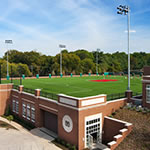Having occupied the same campus since 1915, the Montgomery Bell Academy (MBA) had long outgrown its site five miles outside of downtown Nashville when it enlisted Hastings Architecture Associates to help with an expansion in 2008. With an increase in both its enrollment numbers and its academic and athletic offerings, the all-boys school was feeling the pressure of growth on its infrastructure, its land use, and its residential neighbors.
Having acquired a number of the residential houses along the campus’s southern edge over a period of about sixteen years, the school sought the architects’ guidance in how that acquired land could best be used for both the school and the larger community. Together, along with local residents, they devised a master plan through what principal William Hastings aptly describes as a “robust process” lasting eighteen months and including both “one-on-one meetings at the kitchen table and public community meetings.” The concerns of the school and its neighbors—which regarded solutions for stormwater management, parking needs, lighting, traffic, safety, and the health of a creek that runs through campus—were addressed by the final plan.
“This campus, over the past 100 years, has been a leader in the community and also a conservative institution,” Hastings says. “That the school and its leadership embarked upon a massive transformation to their campus and did so with the greater community and the environment at the forefront of their planning, while also trying to accomplish their academic and athletic needs, is paramount.”

Lowry Hall, like other buildings on campus, uses a combination of pervious hardscaping and native landscaping to minimize both irrigation needs and rainwater runoff.
That transformation included the addition of an enclosed, 300-car parking garage, but in a genius move that preserves green space, the garage’s roof was transformed into a regulation-size soccer pitch including bleachers for at least 700 spectators and stadium lighting for night games. Directly below the field, on the first level of the partially below-grade garage, a 10,000-gallon cistern captures rainwater. Making its way to the cistern through a pipe via drains underneath the field’s turf, the captured water is used to irrigate the campus landscape.
Groundwater from subsurface rock along the garage foundation is also diverted to the cistern. (Much of the excavated rock was crushed on-site and used in the building process.) When the cistern reaches capacity and irrigation needs are fulfilled, excess water makes its way to a bioswale area and is treated before flowing on to Kingfisher Creek. The construction of three large bioswales, located adjacent to the garage and the creek, was one of several water treatment measures implemented as a component of the school’s wider stormwater management plan. Another part of that plan was the remediation of Kingfisher Creek itself.

This study space in Lowry Hall features large windows that provide views to the surrounding trees and neighborhood. Overhead lighting can be dimmed independently to adjust for varying levels of natural light.
The newly created bioswales act as a buffer to prevent excessive erosion but are just one means of treating both captured and runoff water before it makes its way to the stream. The removal of invasive species and the creation of a no-mow, no-touch zone of maintained natural grasses, which acts as a filtration system for surface water, also contribute to the health of the stream. A large sports field nearby uses organic fertilizers. Pervious pavement is used in expanded surface parking lots. And large islands running down the length of a completely renovated lot to the southwest of the campus also function as bioswales.
The buildings address water as well. In the LEED Gold-certified Lowry Hall—a 41,000-square-foot classroom building that marked MBA’s first foray into LEED—low-flow, low-flush fixtures “gave us a water-use reduction of about 50 percent,” says Erica Weeks, an architect in Hastings Architecture’s greenSTUDIO. “We actually save more than 100,000 gallons of water per year through these fixtures,” she says.
Lowry uses a geothermal exchange system that is shared with the campus’s new dining hall, which also is certified LEED Gold. Lowry’s variable refrigerant flow system “allows each classroom to be tuned for its heating and cooling needs,” Weeks says. “So, you’re really dialing in an optimization of your mechanical system.” Not only do lighting control systems and occupancy sensors allow each classroom to manage its energy use on a classroom-by-classroom basis, but rowed pendant lighting fixtures, which are parallel to exterior windows with high-performance glazing, are able to be adjusted and dimmed row-by-row to adjust to natural light.

Custom LED light fixtures hang from the glulam trusses in Montgomery Bell Academy’s voluminous, 300-seat dining hall. Daylighting studies were completed to ensure that the space receives ample natural light but without excessive glare.
Aside from the water-saving fixtures, Lowry’s green features also include water-bottle-filling stations and recycling centers—both of which provide an opportunity for the students to actually see sustainability in action. “The commitment to the environment is evident from the time students walk in the door to the time they leave,” Hastings says. “We took the opportunity to treat the design and construction process as an opportunity to teach.”
Weeks says that the firm is primarily interested in doing the right thing, regardless of points and prerequisites. “With the projects at MBA, a lot of the conversation was about ‘This is the right thing to do,’ regardless of the LEED scorecard,” she says.
Hastings concurs, speaking to the design’s protective measures that preserved open space and undeveloped land: the enclosed parking garage, the soccer field on the roof, the multistory buildings. “That’s what sustainability is about,” he says, “not just bells and whistles that can distract from smart, creative choices that make a positive impact. It’s about good design and planning from the outset.”

